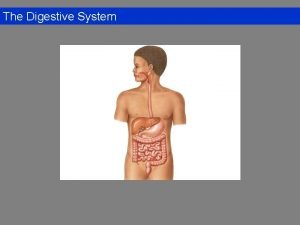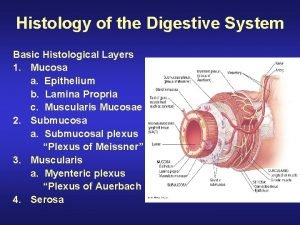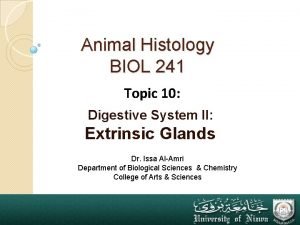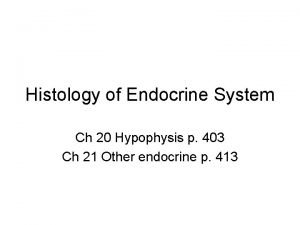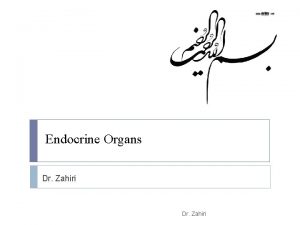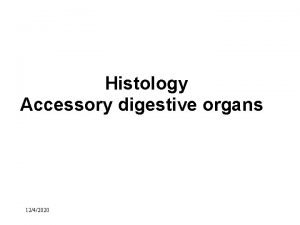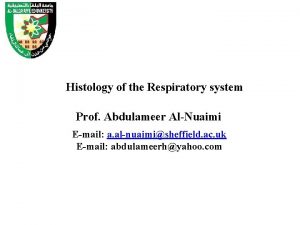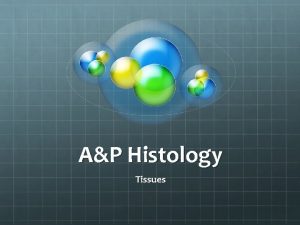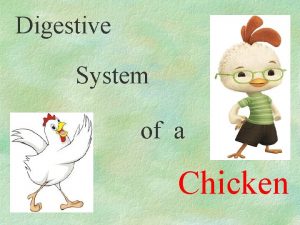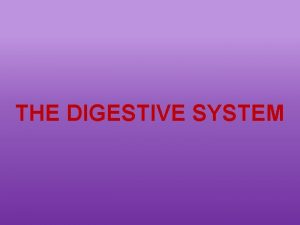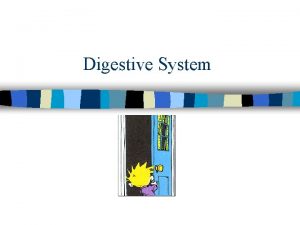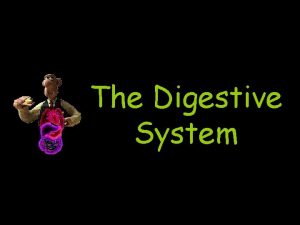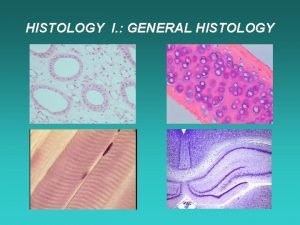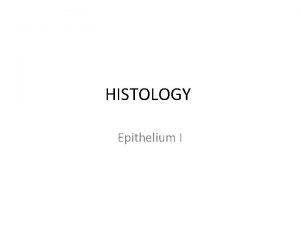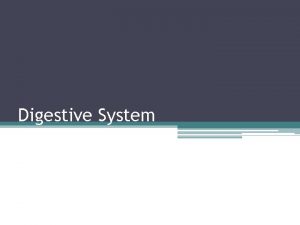Histology Digestive System 10312021 Histology of the Digestive





















































- Slides: 53

������ Histology Digestive System 10/31/2021

Histology of the Digestive System Basic Histological Layers Mucosa . 1 a. Epithelium b. Lamina Propria c. Muscularis Mucosae Submucosa . 2 a. Submucosal plexus “Plexus of Meissner” Muscularis. 1 a. Myenteric plexus “Plexus of Auerbach serosa 10/31/2021 •

GIT histology The small & large intestine 10/31/2021

The oral cavity 10/31/2021

Histology of oral cavity - - The oral cavity is the entrance of the digestive tract It contain the tongue, the gingiva, teeth, lips and salivary glands Oral cavity lines by oral mucous membrane which formed of two parts nonkeratinized stratified squamous epithelium, it is cells are rich in glycogen Lamina propria – of C. T, minor salivary glands, blood vessels and lymph capillaries 10/31/2021

tongue Histology of oral cavity • Muscular organ- made of skeletal muscles • Cover by mucous membrane which is coverd by stratified squamous epithelium nonkeratinized Has two surfaces • Inferior Smooth surface - Cover with oral mucous - Lines with stratified squamous epithelium • Superior rough surface - Cover by mucous membrane which shows small projection called lingual papillae - Lines with stratified squamous 10/31/2021 epithelium partially keratinized

Tongue 10/31/2021

Lingual papillae They are projection of mucous membrane which give the anterior two third of the tongue its characteristics roughness. They are similar in their structures to the intestinal villi Types of papillae: filiform papillae circumvallate papillae fungiform papillae 10/31/2021

10/31/2021

10/31/2021

tongue papillae fungiform papillae They are rounder in shape medium in size they are located along the margins & tip of tongue Red in color due to presence of many capillaries filiform papillae are smallest and more- thread like cone-shaped projections located over anterior part of tongue; 10/31/2021

tongue papillae Circumvallate papillae, are largest of all tongue papillae Cylindrical in shape, in invaginations in the tongue's surface there are located immediately anterior to the V- shaped terminal sulcus Functions Increase surface area of tongue Gripping the food during chewing Contain taste buds 10/31/2021

Tongue papillae 10/31/2021

Fungi form papillae Circumvallate papillae. 10/31/2021

Oesophagus 10/31/2021

Oesophagus 10/31/2021

Oesophagus 10/31/2021

Oesophagus Mucosa: - Stratified squamous non - keratinized epithelium -muscularis mucosa Submucosa: contains Meissner’s plexus and oesophageal glands Muscularis externa: Upper one-third: skeletal fibres Middle one-third: mixed fibres Lower one-third: smooth fibres Adventitia: loose areolar connective tissue 10/31/2021

Oesophagus 10/31/2021

Oesophagus 10/31/2021

MUSCULARIS EXTERNA Arranged in two layers: - Inner layer: Circular - Outer layer: Longitudinal * Between the two layers – Myenteric plexus of nerve fibre and ganglion cells are present. It controls peristaltic movement. TYPES OF MUSCLES: Upper 1/3 rd – Skeletal muscle Middle 1/3 rd – Both skeletal and smooth muscle Lower 1/3 rd – purely smooth muscle 10/31/2021

Stomach 10/31/2021

Stomach Mucosa: simple columnar epithelium and presence of gastric pits. Fundic region (fundus & Ø body) Pyloric region Ø 10/31/2021

Stomach (Fundic Region) Mucosa: simple columnar with oval nuclei, presence of gastric glands in lamina propria. 10/31/2021

Stomach (Fundic Region) Submucosa: contains blood vessels, lymphatics and Meissner’s plexus. Muscularis Externa: an inner oblique (absent in pylorus), middle circular and outer longitudinal layer. Serosa: consist of surface layer of flattened mesothelial cells resting on a thin layer of loose connective tissue with blood vessels and lymphatics. 10/31/2021

Stomach (Pyloric Region) Mucosa: pyloric glands in lamina propria & deeper gastric pits extending half the thickness of mucosa. Muscularis Externa: inner circular (thickened to form pyloric sphincter) and outer longitudinal layer. Submucosa & Serosa: same as in fundic part. 10/31/2021

Stomach (Pyloric Region) 10/31/2021

10/31/2021

Cells of gastric gland 10/31/2021

Cells of gastric gland Mucous neck cells • Parietal (oxyntic) cells • Chief (peptic/zymogen) • cells Enteroendocrine cells • Undifferentiated cells • 10/31/2021

Small Intestine It is divided into duodenum, jejunum and ileum. Mucosa: characteristic features- • Plicae circularis (valves of ü Kerkring) Villi & Microvilli ü Goblet cells (few) ü Crypts of Lieberkuhn (intestinal ü glands) Glands are lined by columnar ü cells, goblet cells, Paneth cells & enteroendocrine cells 10/31/2021

10/31/2021

Small Intestine 10/31/2021

Small Intestine Submucosa: contains blood vessels, lymphatics and Meissner’s plexus. Muscularis externa: Outer longitudinal and inner circular layers of smooth muscle. Serosa/Adventitia 10/31/2021

Duodenum Presence of Brunner’s glands in submucosa 10/31/2021

High power view of the Duodenal Mucosa 10/31/2021

Jejunum Villi are tongue shaped. Absence of Brunner’s glands. Long Crypts of Lieberkuhn 10/31/2021

Ileum Presence of lymphoid aggregations in lamina propria known as Peyer’s patches. Villi are short & finger like. 10/31/2021

Large Intestine It consists of: appendix, colon, rectum and anal canal. Mucosa: Absence of Plicae circulares and villi Presence of Microvilli Presence of Crypts of Lieberkuhn Presence of Goblet cells in large number Submucosa Muscularis externa: Inner circular layer - thin compared to small intestine. Outer longitudinal layer- forms Taenia coli. Adventitia: Appendices epiploicae (peritoneum forms pouch like processes filled with fat) 10/31/2021

Large Intestine 10/31/2021

Large Intestine 10/31/2021

Vermiform Appendix A small blind-ending diverticulum. Large accumulations of lymphoid tissue in lamina propria which may extend into submucosa. Intestinal villi are usually absent. Crypts are poorly formed. Muscularis externa is thin. Absence of taenia coli. 10/31/2021

Vermiform Appendix 10/31/2021

Rectum Intestinal glands are straight, like test tubes. A continuous coat of longitudinal muscle is present. Absence of taenia. Absence of appendices epiploicae. 10/31/2021

Anal Canal Epithelium: upper part-stratified squamous non-keratinized, lower part-covered by true skin (stratified squamous keratinized). Mucosa has characteristic longitudinal folds-Anal columns. Small mucosal folds between the anal columns -Pectinate line. Crypts disappear below this line. Muscularis externa-circular 10/31/2021 muscle forms involuntary

Ano-rectal Junction 10/31/2021

10/31/2021

MCQ Q 1. Stratified squamous non-keratinized epithelium is a feature of: Oesophagus Stomach Appendix Rectum 10/31/2021 . a. b. c. d

MCQ Q 2. Deep gastric pits is a feature of: Oesophagus Cardiac part of stomach Fundic part of stomach Pyloric part of stomach 10/31/2021 . a. b. c. d

MCQ Q 3. Plica circularis is a feature of: Oesophagus Stomach Small intestine Large intestine 10/31/2021 . a. b. c. d

MCQ Q 4. Taenia coli is present in: Oesophagus Stomach Small intestine Large intestine 10/31/2021 . a. b. c. d

MCQ Q 5. Abundant lymphoid tissue in lamina propria is a feature of: Oesophagus Stomach Duodenum Appendix 10/31/2021 . a. b. c. d

Thank you for your steamed audience 10/31/2021
 Serosa vs adventitia
Serosa vs adventitia Histology of digestive tract
Histology of digestive tract Appendixis
Appendixis Hepatocytes function
Hepatocytes function Digestive system respiratory system and circulatory system
Digestive system respiratory system and circulatory system Digestive histology
Digestive histology Nervosa
Nervosa Histology of accessory digestive organs
Histology of accessory digestive organs Nervous system and digestive system
Nervous system and digestive system Hình ảnh bộ gõ cơ thể búng tay
Hình ảnh bộ gõ cơ thể búng tay Bổ thể
Bổ thể Tỉ lệ cơ thể trẻ em
Tỉ lệ cơ thể trẻ em Chó sói
Chó sói Tư thế worm breton là gì
Tư thế worm breton là gì Alleluia hat len nguoi oi
Alleluia hat len nguoi oi Các môn thể thao bắt đầu bằng từ đua
Các môn thể thao bắt đầu bằng từ đua Thế nào là hệ số cao nhất
Thế nào là hệ số cao nhất Các châu lục và đại dương trên thế giới
Các châu lục và đại dương trên thế giới Công thức tính thế năng
Công thức tính thế năng Trời xanh đây là của chúng ta thể thơ
Trời xanh đây là của chúng ta thể thơ Mật thư tọa độ 5x5
Mật thư tọa độ 5x5 101012 bằng
101012 bằng độ dài liên kết
độ dài liên kết Các châu lục và đại dương trên thế giới
Các châu lục và đại dương trên thế giới Thơ thất ngôn tứ tuyệt đường luật
Thơ thất ngôn tứ tuyệt đường luật Quá trình desamine hóa có thể tạo ra
Quá trình desamine hóa có thể tạo ra Một số thể thơ truyền thống
Một số thể thơ truyền thống Cái miệng xinh xinh thế chỉ nói điều hay thôi
Cái miệng xinh xinh thế chỉ nói điều hay thôi Vẽ hình chiếu vuông góc của vật thể sau
Vẽ hình chiếu vuông góc của vật thể sau Nguyên nhân của sự mỏi cơ sinh 8
Nguyên nhân của sự mỏi cơ sinh 8 đặc điểm cơ thể của người tối cổ
đặc điểm cơ thể của người tối cổ V. c c
V. c c Vẽ hình chiếu đứng bằng cạnh của vật thể
Vẽ hình chiếu đứng bằng cạnh của vật thể Fecboak
Fecboak Thẻ vin
Thẻ vin đại từ thay thế
đại từ thay thế điện thế nghỉ
điện thế nghỉ Tư thế ngồi viết
Tư thế ngồi viết Diễn thế sinh thái là
Diễn thế sinh thái là Các loại đột biến cấu trúc nhiễm sắc thể
Các loại đột biến cấu trúc nhiễm sắc thể Các số nguyên tố là gì
Các số nguyên tố là gì Tư thế ngồi viết
Tư thế ngồi viết Lời thề hippocrates
Lời thề hippocrates Thiếu nhi thế giới liên hoan
Thiếu nhi thế giới liên hoan ưu thế lai là gì
ưu thế lai là gì Hươu thường đẻ mỗi lứa mấy con
Hươu thường đẻ mỗi lứa mấy con Khi nào hổ mẹ dạy hổ con săn mồi
Khi nào hổ mẹ dạy hổ con săn mồi Sơ đồ cơ thể người
Sơ đồ cơ thể người Từ ngữ thể hiện lòng nhân hậu
Từ ngữ thể hiện lòng nhân hậu Thế nào là mạng điện lắp đặt kiểu nổi
Thế nào là mạng điện lắp đặt kiểu nổi The parts of the respiratory system
The parts of the respiratory system Ppt
Ppt Papillary layer of dermis
Papillary layer of dermis
